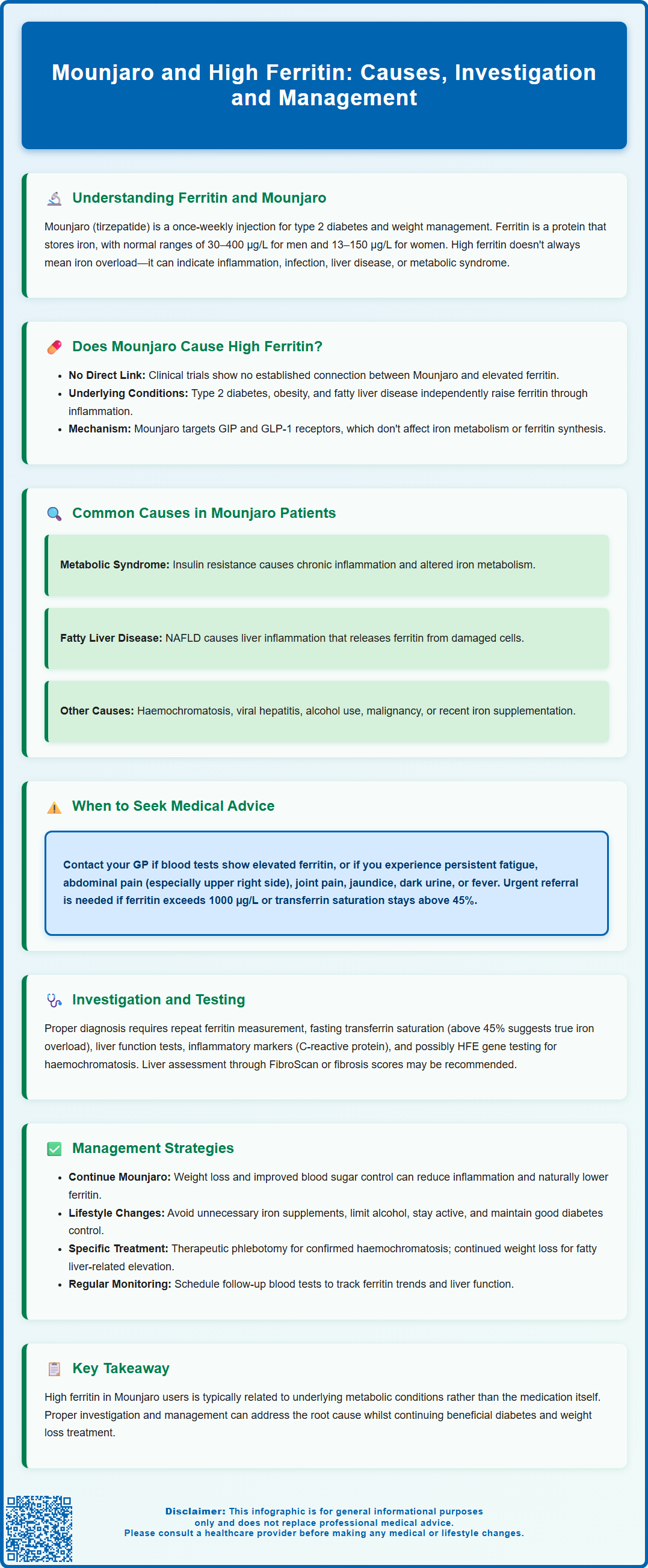
Mounjaro (tirzepatide) is a dual GIP and GLP-1 receptor agonist licensed in the UK for type 2 diabetes and weight management. Some patients taking Mounjaro may discover elevated ferritin levels during routine blood tests, raising questions about a possible connection. Ferritin is a protein that stores iron and serves as a marker for iron status, inflammation, and liver health. Whilst Mounjaro itself does not directly cause high ferritin, patients prescribed this medication often have underlying conditions—such as metabolic syndrome, obesity, or non-alcoholic fatty liver disease—that independently raise ferritin levels. Understanding this relationship helps ensure appropriate investigation and management of elevated ferritin whilst continuing effective diabetes or weight management treatment.
Summary: Mounjaro (tirzepatide) does not directly cause elevated ferritin levels, but patients taking it often have underlying conditions such as metabolic syndrome, obesity, or fatty liver disease that independently raise ferritin as an inflammatory marker.
Mounjaro (tirzepatide) is a once-weekly injectable medication licensed in the UK for the treatment of type 2 diabetes mellitus and, more recently, for weight management in adults with obesity or overweight with weight-related comorbidities as an adjunct to reduced-calorie diet and increased physical activity. It works as a dual glucose-dependent insulinotropic polypeptide (GIP) and glucagon-like peptide-1 (GLP-1) receptor agonist, enhancing insulin secretion, suppressing glucagon release, slowing gastric emptying, and reducing appetite. These combined mechanisms lead to improved glycaemic control and significant weight loss in clinical trials.
Ferritin is a protein that stores iron in the body, primarily in the liver, spleen, and bone marrow. Serum ferritin levels are commonly measured to assess iron stores and help diagnose conditions such as iron deficiency anaemia or iron overload disorders like haemochromatosis. Ferritin reference ranges vary by laboratory, age and sex, but typically fall between approximately 30–400 micrograms per litre (µg/L) for men and 13–150 µg/L for women. It's important to check your local laboratory's specific reference ranges when interpreting results.
Elevated ferritin levels can indicate several conditions beyond iron overload, including inflammation, infection, liver disease, metabolic syndrome, or malignancy. Because ferritin is an acute-phase reactant, it rises during inflammatory states, making interpretation sometimes complex. Patients taking Mounjaro for diabetes or weight management may have their ferritin levels checked as part of routine monitoring or investigation of symptoms, leading to questions about whether the medication itself might influence these results. Understanding the relationship between Mounjaro and ferritin requires careful consideration of the drug's pharmacology, the patient's underlying health conditions, and other contributing factors.

There is no established link between Mounjaro (tirzepatide) and elevated ferritin levels based on current clinical trial data and prescribing information approved by the Medicines and Healthcare products Regulatory Agency (MHRA) and the European Medicines Agency (EMA). The Summary of Product Characteristics (SmPC) for Mounjaro does not list raised ferritin as a recognised adverse effect, and large-scale clinical trials such as SURPASS and SURMOUNT have not reported ferritin elevation as a significant safety signal. However, it's worth noting that ferritin was not routinely measured in all clinical trials, so rare effects cannot be completely excluded.
The mechanism of action of tirzepatide—targeting GIP and GLP-1 receptors to regulate glucose metabolism and appetite—has no known direct effect on iron metabolism or ferritin synthesis pathways. Unlike some medications that interfere with haematopoiesis or hepatic function in ways that might alter ferritin, tirzepatide's pharmacological profile does not suggest a causal relationship with iron storage protein levels.
However, it is important to recognise that patients prescribed Mounjaro often have underlying conditions such as type 2 diabetes, obesity, metabolic syndrome, or non-alcoholic fatty liver disease (NAFLD), all of which are independently associated with elevated ferritin levels. These conditions frequently involve chronic low-grade inflammation, insulin resistance, and hepatic dysfunction—factors known to raise ferritin as an acute-phase reactant.
Therefore, whilst Mounjaro itself does not appear to cause high ferritin directly, the patient population receiving this treatment may be at increased baseline risk for elevated ferritin due to their metabolic and inflammatory profiles. Any observed elevation in ferritin should be interpreted in the broader clinical context rather than automatically attributed to the medication.
If you suspect Mounjaro might be causing any adverse effect, including raised ferritin, you can report this through the MHRA Yellow Card scheme at yellowcard.mhra.gov.uk or via the Yellow Card app.
When a patient on Mounjaro presents with high ferritin, several potential causes should be considered, many of which relate to their underlying health conditions rather than the medication itself.
Metabolic syndrome and insulin resistance are strongly associated with hyperferritinaemia. Patients with type 2 diabetes and obesity—the primary indications for Mounjaro—often exhibit elevated ferritin as part of a dysmetabolic state characterised by chronic inflammation, oxidative stress, and altered iron homeostasis. Studies have shown that insulin resistance correlates with increased ferritin levels, independent of body iron stores.
Non-alcoholic fatty liver disease (NAFLD) and its progressive form, non-alcoholic steatohepatitis (NASH), are common in people with obesity and diabetes. These conditions cause hepatic inflammation and cellular damage, leading to ferritin release from hepatocytes. Elevated ferritin is a recognised marker of liver injury and disease severity in NAFLD, and many Mounjaro users will have some degree of hepatic steatosis.
Chronic inflammation from any source—including obesity itself, which is considered a pro-inflammatory state—can elevate ferritin as an acute-phase protein. Conditions such as rheumatoid arthritis, inflammatory bowel disease, or chronic infections may coexist in patients taking Mounjaro and contribute to raised ferritin levels.
Other causes to consider include:
Haemochromatosis or other iron overload disorders
Viral hepatitis (such as hepatitis B or C)
Excessive alcohol consumption, which can damage the liver and raise ferritin
Malignancy, particularly haematological cancers
Chronic kidney disease, which may alter iron metabolism often due to inflammation rather than iron overload
Recent blood transfusions or iron supplementation
A thorough clinical assessment, including liver function tests, inflammatory markers (such as C-reactive protein), transferrin saturation (preferably fasting, morning samples), and consideration of the patient's full medical history, is essential to identify the underlying cause of elevated ferritin. Transferrin saturation >45% suggests possible iron overload, helping differentiate this from inflammatory causes of hyperferritinaemia.
Patients taking Mounjaro who discover they have elevated ferritin levels during routine blood tests should contact their GP or diabetes specialist for further evaluation. Whilst high ferritin alone may not cause symptoms, it can indicate underlying conditions requiring investigation and management.
Seek medical advice promptly if you experience:
Persistent fatigue or weakness that interferes with daily activities
Abdominal pain or discomfort, particularly in the upper right quadrant, which may suggest liver involvement
Joint pain or swelling, especially in the hands, which can occur in haemochromatosis
Unexplained weight loss (beyond expected weight reduction from Mounjaro)
Yellowing of the skin or eyes (jaundice), indicating possible liver dysfunction
Dark urine or pale stools
Persistent fever or signs of infection
Your healthcare provider will likely arrange further investigations to determine the cause of elevated ferritin, which typically includes:
Repeat ferritin measurement to confirm the elevation, ideally when any acute illness has resolved
Fasting transferrin saturation (morning sample when possible) to assess for iron overload
Liver function tests (ALT, AST, GGT, bilirubin) to evaluate hepatic health
Inflammatory markers such as C-reactive protein (CRP) to identify inflammation
Full blood count to check for anaemia or other haematological abnormalities
HFE gene testing if haemochromatosis is suspected
Urgent specialist referral is recommended if:
Ferritin is >1000 µg/L
Transferrin saturation is persistently >45% with abnormal liver function tests
There are clinical features suggesting significant iron overload or liver disease
In some cases, liver assessment may be recommended to evaluate for fatty liver disease or fibrosis. This may include calculation of FIB-4 or NAFLD Fibrosis Score, and in selected cases, Enhanced Liver Fibrosis (ELF) test or FibroScan, in line with NICE guidance (NG49). Early identification of the underlying cause allows for appropriate management and prevents potential complications such as liver cirrhosis, diabetes complications, or cardiac dysfunction associated with iron overload.
Management of elevated ferritin in patients taking Mounjaro depends on identifying and addressing the underlying cause whilst continuing diabetes or weight management treatment as appropriate.
If the elevated ferritin is due to inflammation or metabolic syndrome, continuing Mounjaro may actually be beneficial. Weight loss and improved glycaemic control achieved with tirzepatide can reduce systemic inflammation, improve insulin sensitivity, and may help lower ferritin levels over time in patients with NAFLD and metabolic syndrome.
Lifestyle modifications remain fundamental:
Dietary considerations: Avoid iron supplements unless specifically advised by your doctor. If iron overload is confirmed, moderating intake of red meat and organ meats may be recommended, but don't restrict iron-containing foods unnecessarily without medical advice
Limiting alcohol consumption, as alcohol can worsen liver inflammation and iron accumulation
Regular physical activity, which supports weight management and metabolic health
Optimising diabetes control through medication adherence and blood glucose monitoring
If iron overload is confirmed (elevated transferrin saturation and genetic testing positive for haemochromatosis), therapeutic phlebotomy (venesection) is the standard treatment. This involves regular blood removal to reduce iron stores, typically aiming for a maintenance ferritin level of 50-100 µg/L, and is performed under specialist supervision. Mounjaro can generally be continued during phlebotomy treatment unless contraindicated for other reasons.
For NAFLD-related ferritin elevation, management focuses on:
Continued weight loss with Mounjaro as an adjunct to diet and exercise
Assessment of fibrosis risk using non-invasive tests (FIB-4, NAFLD Fibrosis Score)
Hepatology referral if advanced fibrosis is suspected
Monitoring liver function and addressing cardiovascular risk factors
Regular monitoring is essential. Your healthcare team will schedule follow-up blood tests to track ferritin trends, liver function, and metabolic parameters. Do not stop Mounjaro without consulting your prescriber, as discontinuation may worsen glycaemic control or lead to weight regain. If concerns arise about continuing the medication, discuss alternative diabetes or weight management options with your doctor. A collaborative approach between your GP, diabetes specialist, and potentially a haematologist or hepatologist ensures comprehensive care addressing both your metabolic condition and elevated ferritin.
No, there is no established direct link between Mounjaro (tirzepatide) and raised ferritin levels based on clinical trial data and UK regulatory information. Elevated ferritin in patients taking Mounjaro typically reflects underlying conditions such as metabolic syndrome, obesity, or fatty liver disease rather than the medication itself.
Common causes include metabolic syndrome, insulin resistance, non-alcoholic fatty liver disease, chronic inflammation from obesity, haemochromatosis, viral hepatitis, excessive alcohol consumption, or malignancy. A thorough clinical assessment with liver function tests, transferrin saturation, and inflammatory markers helps identify the underlying cause.
Do not stop Mounjaro without consulting your prescriber, as discontinuation may worsen glycaemic control or cause weight regain. Your healthcare provider will investigate the cause of elevated ferritin and determine whether continuing Mounjaro is appropriate whilst addressing the underlying condition.
The health-related content published on this site is based on credible scientific sources and is periodically reviewed to ensure accuracy and relevance. Although we aim to reflect the most current medical knowledge, the material is meant for general education and awareness only.
The information on this site is not a substitute for professional medical advice. For any health concerns, please speak with a qualified medical professional. By using this information, you acknowledge responsibility for any decisions made and understand we are not liable for any consequences that may result.
Lorem ipsum dolor sit amet, consectetur adipiscing elit, sed do eiusmod tempor incididunt ut labore et dolore magna aliqua. Ut enim ad minim veniam, quis nostrud exercitation ullamco laboris nisi ut aliquip ex ea commodo consequat. Duis aute irure dolor in reprehenderit in voluptate velit esse cillum dolore eu fugiat nulla pariatur.
Block quote
Ordered list
Unordered list
Bold text
Emphasis
Superscript
Subscript